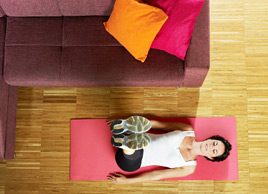Get a stronger core in 4 easy steps
A strong core is more than just pretty abs. Here’s how to strengthen your core to make you stronger for all your daily activities

Source: Web exclusive: November 2010
Getting out of a vehicle, stepping over the tub, riding on a train, carrying groceries or simply walking outside in the winter or on a beach are all examples of real-life situations where a strong, functional core will help you continue with everyday activities safely. But what is the core really, and what’s the best way to strengthen it? Read on for all the details you need.
Anatomy and functions of the primary core muscles
‘ Rectus abdominis: flexes the trunk
‘ Erector spinae: extends the spine and keeps you upright
‘ Internal and external obliques: side bends and rotates the spine; tilts the pelvis
Anatomy and functions of the deep core muscles
‘ Pelvic floor muscles: support the pelvic organs such as the bladder, intestines and uterus (females) and prostate (males)
‘ Multifidus: provides postural stability between the vertebrae
‘ Transverse abdominus: acts as an internal weight belt by compressing the internal organs and stabilizing the spine
During movement, the gluteals, hamstrings, hip flexors, quadrates lumborum and latissimus dorsi can all be regarded as being major players of the core.
Overall functions of the core musculature
‘ Stabilizes the torso over the pelvis. If our spine is malaligned, this causes the rib cage to shift from the ideal position over the pelvis. When this occurs, we lose our ability to effectively engage the core and maintain an upright, stress-free posture.
‘ Reduce the incidence of muscle strains, herniated disc, sciatica and other injuries.
By taking into consideration that the body moves in a front-to-back, side-to-side and rotational manner, a program that contains each of these three movement patterns will better prepare your core for your daily activities as well as injury reduction. Having "pretty abs" is one thing, but having a functional core is another.




